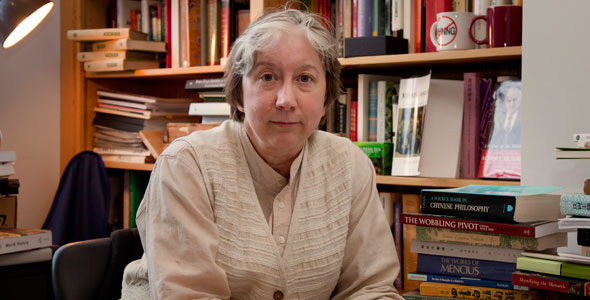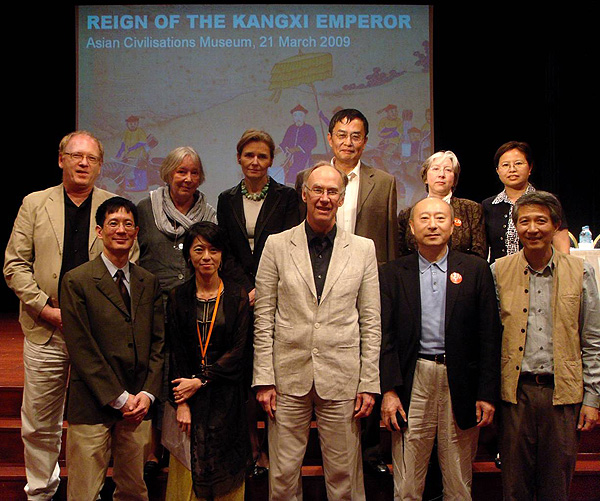Beyond the culture: my comments on New Qing history

Pamela Kyle Crossley

Professor Crossley participated in the conference on “Reign of the Kangxi Emperor” on March 21, 2009
Pamela Kyle Crossley (1955- ), a history professor at Dartmouth College and an expert on Qing history, modern and contemporary Chinese history, comparative history and global history, has won the Guggenheim Fellowship and the Joseph Levenson Prize from the Association for Asian Studies. She has published various books, including A Translucent Mirror: History and Identity in Qing Imperial Ideology and What is Global History?
Professor Hou studied Manchu and Qing history under the guidance of the famous Sinologist Pamela Kyle Crossley at Dartmouth College from February to August 2013. In order to better understand the study of Qing history, Professor Hou sat down with Crossley to discuss some specific questions about the New Qing history.
Hou Deren: The New Qing history has emerged as one of the most important research topics in the field of Chinese history in the U.S. in recent years. A group of representative people and works appeared in the area of the New Qing history. Affected by this, Chinese mainland, Chinese Taiwan and Chinese Hong Kong have seen a resurgence of interest in the study of the New Qing history in the last two or three years.
The concept of New Qing history was put forward in the U.S. and you were regarded as a member of the school of the New Qing history. Your composition A Translucent Mirror: History and Identity in Qing Imperial Ideology and Mark Elliott’s The Manchu’s Way: The Eight Banners and Ethnic Identity in Late Imperial China, Evelyn Rawski’s The Last Emperors: A Social History of Qing Imperial Institutions, Edward Rhoads’s Manchus and Han: Ethnic Relations and Political Power in Late Qing and Early Republican China, 1861-1928 have been called The Four Books of New Qing history. In light of this, why are you reluctant to be called a member of the New Qing History School?
Pamela Crossley: This is a very important question. Very few people use the phrase “New Qing history” to describe their compositions. Only Mark Elliott, James. A. Millward, Ruth.W. Dunnell and Philippe Foret use New Qing history to describe their area of expertise. They argued that the Qing Empire has its own peculiarities, which differentiate it from the previous empires in China. And the reason is that the rule of Qing Empire has a strong element of Manchu and its unique characteristics. I basically agree with this view. But I think the question is whether the New Qing history or New Qing History School is really accurate and appropriate.
I think both of these two appellations are inaccurate. First, many historians have discussed the Manchu aspect of the Qing Dynasty’s governance before Elliott. That’s not a new idea. I’m afraid it could not be called New Qing history. Second, the formulation of New Qing history is also wrong. A long article written by an American scholar said the New Qing History School has 100 members. I’m not sure there are quite so many. But the research subjects and ideas of these scholars are basically not the same or similar. So it’s difficult to refer to them as the New Qing History School.
Hou Deren: As we know, the appellation of New Qing history has been widely used and made a great impact on academia. We cannot find another word to replace it, so we just call it New Qing history. Would you please give me a brief introduction about the origin of the term New Qing history?
Pamela Crossley: The study of New Qing history comes from the mid-1990s. Evelyn Rawski gave a speech titled “Re-envisioning the Qing: The Significance of the Qing Period in Chinese history” at the annual meeting of the Association for Asian Studies in 1996.This speech particularly criticized the question of the “Sinicization” of the Qing Dynasty’s governors raised by Ping-ti Ho in his article “The Significance of the Ch’ing Period in Chinese History in 1967”.
Evelyn Rawski’s thinking was based on a Manchu-centric concept of history, indicating that the main reason the Qing Dynasty could successfully govern China for near 300 years was not the result of Sinicization but the Qing Dynasty’s governors’ focus on retaining the characteristics of Manchu culture. They used these characteristics of the Manchu to strengthen the relations of other nationalities. So they built a multiracial empire that included Manchu, Han, Mongol, Tibetan, Uighur and other nationalities.
Immediately, Ping-ti Ho wrote the article “In Defense of Sinicization: A Rebuttal of Evelyn Rawski’s ‘Re-envisioning the Qing’”. This article argued that the Sinicization of nationalities is a historical fact in Chinese history. The Manchu is a nationality with a high level of Sinicization. The Sinicization of non-Han nationalities enlarged the connotations of the Sinic culture.
Ping-ti Ho used this article to refute Evelyn Rawski’s Manchu-centrism. Many theses and monographs about this theme appeared in American academia after this famous debate. Research of New Qing history was gradually on the rise. Mark Elliott, James. A. Millward, Edward Rhoads, Evelyn Rawski and other people became the main representatives of the so-called New Qing History School. Some regarded me as one of them, but I hold back my opinions on this viewpoint.
Hou Deren: Would you please make a comment on the main viewpoints of representative scholars about New Qing history? What do you think of the Manchu-centered theses from the scholars of New Qing history?
Pamela Crossley: The viewpoints of New Qing history scholars were enlightening but also had some significant limitations. For example, Manchu-centric theories regarded the Qing Empire as a Manchu empire. Evelyn Rawski’s Re-envisioning the Qing and Mark Elliott’s The Manchu’s Way are representative works of this viewpoint. Mark Elliott repeatedly claimed the significance of Manchu-centric theory in his book. He even regarded Manchu-centrism as an equal research perspective to the “research of Qing history”. But I cannot agree.
Some scholars treated me as a member of the Manchu-centric camp. This is obviously wrong. I was not aligned with Mark Elliott on the view of studies on the Qing and Manchu history. We were even tit-for-tat. I think it’s a mistake to regard the Qing Dynasty as a Manchu Empire. We should not reduce the Qing Dynasty’s governance and policy to Manchu-centrism or Manchu-culture-centrism for the reason that Qing Dynasty’s governors and even imperators are Manchu. This view is fairly one sided.
The Qing Dynasty’s governance possessed Manchu elements. But we couldn’t regard Manchu as the center. In my opinion, the Qing Dynasty’s governance is a political structure of the empire. This is based on facts. First, the Qing Dynasty was under the emperor’s rule. The emperor was not only a person. He also represented a kind of governing system. The existence of an emperor system is the first characteristic of the empire’s governance.
Second, the Qing Dynasty’s governance structure is very special. It had three kinds of government systems. The first was the Manchu’s own “Eight Banners”. It was a political organizational form of united army and government. The second was the government of Mongolia which was renamed as lifanyuan later. It was the highest administrative machinery that managed Mongol and other minorities. The third was a management system from the former Ming Dynasty.
The Qing Dynasty combined these three different kinds of management systems into one empire. This is the second characteristic of the empire’s governance. Lastly, the territory governed by the Qing Dynasty was very vast. Many different cultures were taken into one empire’s governance. This is the third characteristic of the empire’s governance.
On the view of the order of land under heaven structured by the governor of Qing Empire, the expression of imperial power or authority has the characteristic “simultaneities”. The Qing Empire combined several different governances into the imperial power or authority successfully. These governances played a different role in different territories.
As a result, the discussion of the Manchu-centrism is meaningless on the view of the order of land under heaven. Most of the time, the Qing Dynasty’s emperor only regarded the Manchu people as a part of a multinational empire. A real empire is not attached to one culture. It is the existence that beyond the culture. So does the empire’s imperial power or authority.
Manchu culture and history are a part of the Qing Empire’s history, which includes Sinic culture, Manchu culture, Mongol culture, other ethnic cultures, and even various religious cultures. I have pointed out in my book A Translucent Mirror that the Qing Dynasty was an empire and the Qing Empire’s culture includes various different cultures’ traditions and histories under its governance.
Hou Deren is an associate professor from the History Department at Soochow University.
The Chinese version appeared in Chinese Social Sciences Today, No. 641, Sept. 1, 2014
Edited by Zhang Mengying
